Agaricus xanthodermus Genev., 1876

(Da: www.funghiitaliani.it)
Phylum: Fungi Linnaeus, 1753
Classe: Agaricomycetes Doweld, 2001
Ordine: Agaricales Underw., 1899
Famiglia: Agaricaceae Chevall., 1826
Genere: Agaricus L., 1753
Italiano: Prataiolo tossico
English: Yellow-staining mushroom, Yellow-stainer
Français: Agaric jaunissant
Deutsch: Karbolegerling
Specie e sottospecie
Agaricus xanthodermus ssp. ammophilus (Menier) J.M. Losa, 1969 - Agaricus xanthodermus ssp. xanthodermus Genev. 1876 - Agaricus xanthodermus var. antibioticus Cleland & J.R. Harris 1948 - Agaricus xanthodermus var. croceus Raithelh., 1974 = Agaricus xanthodermus var. griseus (A. Pearson) Bon & Cappelli, 1983 - Agaricus xanthodermus var. lepiotoides Maire, 1911 - Agaricus xanthodermus var. meleagrioides (A. Pearson) Bon & Cappelli, 1983 - Agaricus xanthodermus var. obscuratus Maire, 1910 - Agaricus xanthodermus var. pilatianus Bohus, 1971 - Agaricus xanthodermus var. xanthodermus Genev., 1876.
Descrizione
Fungo "prataiolo" tossico; può essere facilmente identificato per via del suo odore sgradevole e perché la carne alla base del gambo è di colore giallo paglierino. Cappello: di dimensioni medio-piccole, 8-12 cm di larghezza, a volte poco più grande. Da campanulato/trapezoidale ad emisferico, infine piano; poco consistente, di colore bianco, a volte più scuro al centro. Al tocco vira velocemente al giallo paglierino. Lamelle: piuttosto fitte, libere. Dapprima bianche, poi bianco-sporco, infine brune e nerastre per via della sporata. Anello: ampio, di colore bianco, dentellato al bordo. Carne: di colore bianco, vira rapidamente al giallo se viene sezionata, di colore giallo chiaro alla base del gambo. Odore: forte, molto sgradevole, come di inchiostro o di fenolo; se viene cucinato, si può percepire chiaramente un odore forte di "inchiostro" nell'ambiente di cottura. Talvolta l'odore è poco percepibile oppure subnullo: in tal caso strofinare vigorosamente il cappello o le lamelle. Tossico, provoca sindrome gastro-intestinale di lieve entità. La tossicità di questa specie non è costante, in quanto a volte chi la consuma non accusa problemi gastro-intestinali.
Diffusione
In autunno, nelle radure erbose dei boschi oppure nei parchi cittadini.
Sinonimi
= Agaricus meleagris var. grisea (A. Pearson) Wasser, Ukr. bot. Zh. 35(5): 516 (1978) = Agaricus pseudocretaceus Bon, Docums Mycol. 15(no. 60): 34 (1985) = Agaricus xanthodermus var. griseus (A. Pearson) Bon & Cappelli, Docums Mycol. 13(no. 52): 16 (1983) = Agaricus xanthodermus var. lepiotoides Maire, (1911) 0 Agaricus xanthodermus Genev., Bull. Soc. bot. Fr. 23: 28 (1876) var. xanthodermus = Pratella xanthoderma (Genev.) Gillet, Champignons de France. Tableaux Analytiques des Hyménomycétes (Alençon): 129 (1884) = Psalliota flavescens Richon & Roze, (1888) = Psalliota xanthoderma (Genev.) Richon & Roze,: 53 (1885) = Psalliota xanthoderma var. grisea A. Pearson, Trans. Br. mycol. Soc. 29(4): 204 (1946) = Psalliota xanthoderma var. lepiotoides (Maire) Rea, Brit. basidiomyc. (Cambridge): 85 (1922).
Bibliografia
–"Agaricus xanthodermus Genev". Species Fungorum. CAB International.
–Roger Phillips. "Agaricus xanthodermus".
–Nowadays there is also a French Mycological Society Archived September 28, 2012, at the Wayback Machine, but in 1876 fungi were considered under botany.
–See the entry in Index Fungorum.
–Genevier L. G. (1876). "Étude sur les champignons consommés à Nantes sous le nom de champignon rose ou de couche (Agaricus campestris L.)". Bulletin de la Société Botanique de France (in French). 23: 28-35.
–"Marcel Bon (1987). The Mushrooms and Toadstools of Britain and North-Western Europe. Hodder & Stoughton. p. 278.
–Courtecuisse, R. & Duhem, B. (1994). Guide des champignons de France et d'Europe. Delachaux et Niestlé. p. 258.
–See Meinhard Moser (1983). Keys to Agarics and Boleti. Translated by Simon Plant. 15a Eccleston Square, London: Roger Phillips. p. 238.
–Binomial names may take the form "noun + adjective", "noun + nominative noun" or "noun + genitive noun" as explained in this section of the Binomial nomenclature article. There is agreement in gender only in the "noun + adjective" case (as in Agaricus xanthodermus, which means something like "yellow-skinned Agaricus"), but Agaricus xanthoderma is the second type (like "Agaricus yellow-skin") and there the endings do not agree. Another similar example is Agaricus silvicola (which means "Agaricus, inhabitant of the woods").
–Demirel K, Uzun Y, Kaya A (2004). "Some Poisonous Fungi of East Anatolia" (PDF). Turk J Bot. 28: 215–19. Archived from the original (PDF) on 2005-05-05.
–Asef Shayan, M.R. (2010). Qarch-ha-ye Sammi-ye Iran - [Poisonous mushrooms of Iran] (in Persian). Iran shenasi. p. 214.
–Van der Westhuizen, GCA and Eicker, A (1994) Mushrooms of Southern Africa, Field Guide. Struik Publishers, Cape Town.
–Peter Jordan (2000). The Mushroom Guide and Identifier: The Ultimate Guide to Identifying, Picking and Using Mushrooms. London: Hermes House. p. 100.
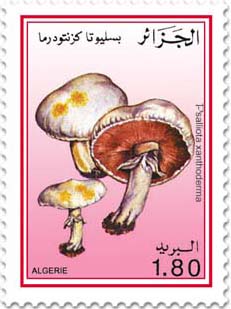
|
Data: 14/12/1989
Emissione: Funghi Stato: Algeria |
|---|
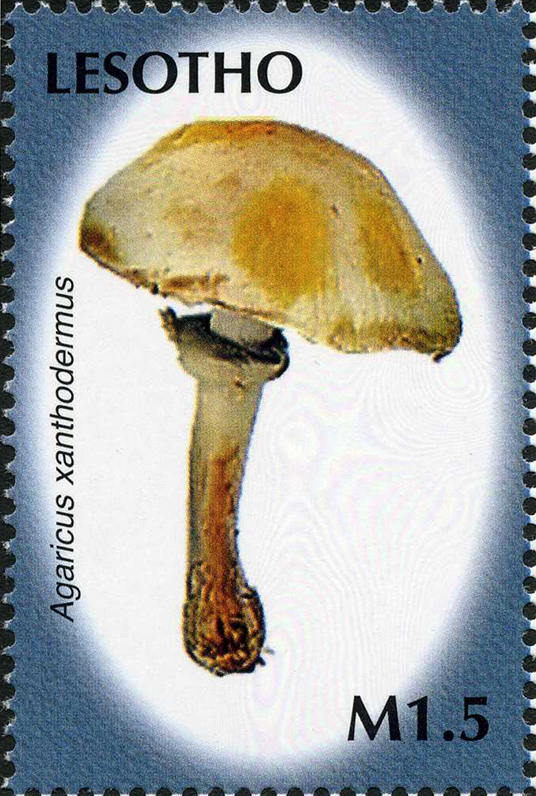
|
Data: 20/08/2007
Emissione: Funghi Stato: Lesotho |
|---|
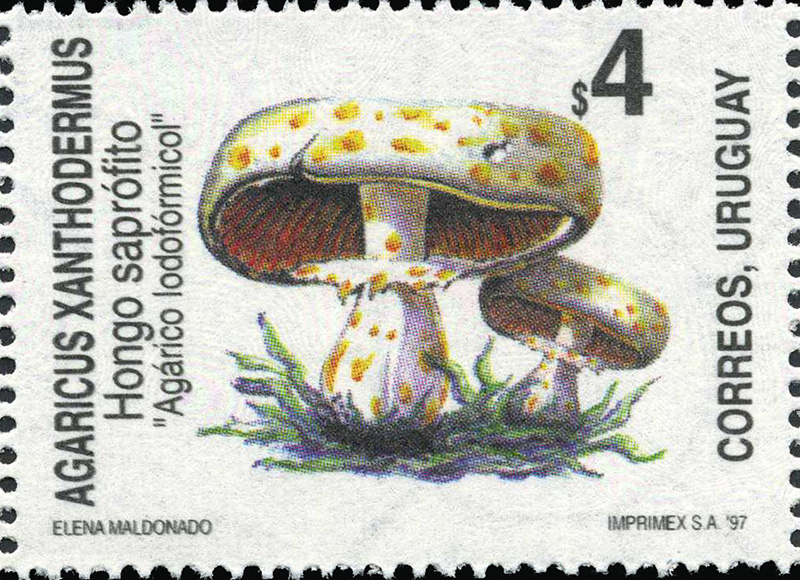
|
Data: 07/02/1997
Emissione: Funghi Stato: Uruguay |
|---|

|
Data: 01/01/2000
Emissione: Funghi Stato: Angola |
|---|
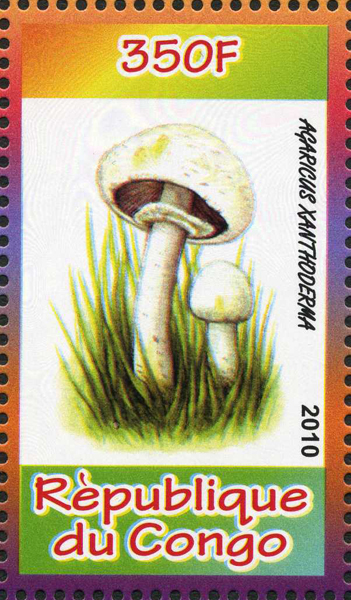
|
Data: 01/01/2010
Emissione: I funghi e Disney Stato: Congo (Brazaville) |
|---|
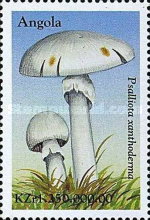
|
Data: 23/09/1999
Emissione: Funghi Stato: Angola |
|---|
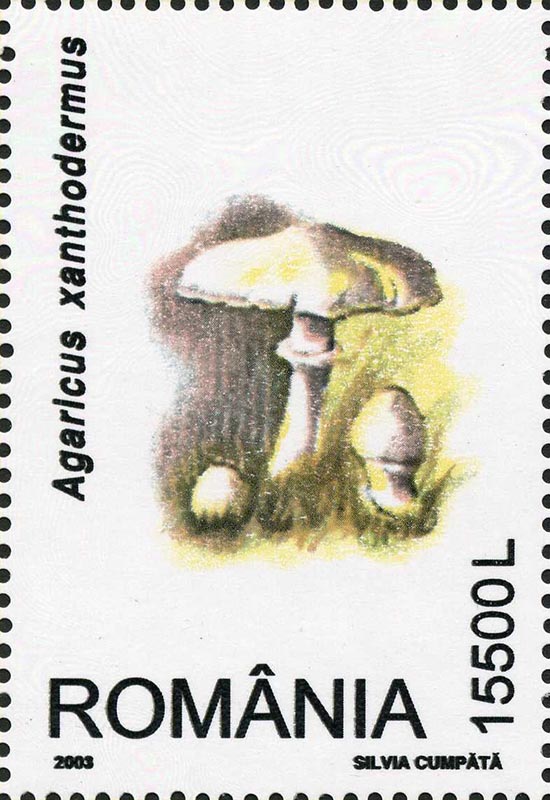
|
Data: 19/09/2003
Emissione: Funghi Stato: Romania |
|---|
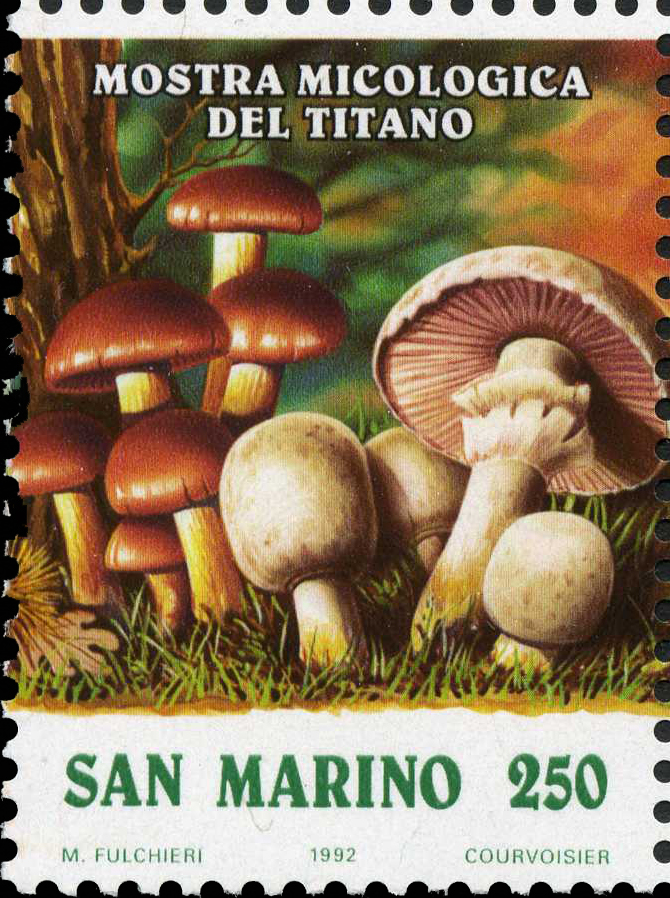
|
Data: 18/09/1992
Emissione: Mostra micologica Stato: San Marino |
|---|
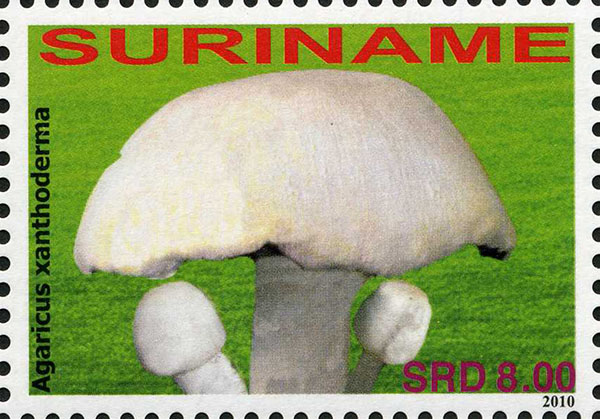
|
Data: 24/02/2010
Emissione: Funghi Stato: Suriname Nota: Emesso in striscia di 3 v. diversi |
|---|